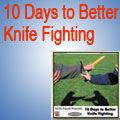
Switching Leads: Dangerous
Move or Useful Tactic?
|
What stance do you take at the beginning of a fight? Is your
In the beginning of a real confrontation, I would probably
I have noticed, admittedly a lot more in a class situation than
Your opponent leads with a left foot forward, so you lead with your
All of a sudden, your opponent switches to a right lead. You
What do you do?
Isn't the answer obvious? Don't switch leads.
Don't allow your opponent the opportunity to take you out of your
"OK Kids, get your right punch ready. Now, when the opponent
The kids repond by hitting with their right hand. If, instead of
If the opponent strikes with an elbow, my students still hit
Don't get me wrong.They aren't limited to only punching with theirright hands. But isn't it comforting to know that they can't be faked into a lead switch by their opponent. They don't have to switch leads to be able to execute a technique. Either side is fine for them.
I tell my students to pick a lead (usually their dominant side forward).
On the flip side of the coin, what a great technique to use on an
Get it? In order to find out if your opponent is uncomfotable when
You get very comfortable with distance and timing strategy. Switch
(Be careful: You may be too subtle, or too far out to cause that
Re: Timing. I'd switch just as your coming into a natural pause.
Try out lots of possibilities during practice. Get comfortable with
Final thought:Is there anyone who remembers the cigarrette commercialfrom the 60s that said, "I'd rather fight than switch"? Even though I have yet to smoke a cig., those words take on a new meaning.
Bonus Tip:If you'd like to take the above strategy to the next level, thinkabout creating an uncomfortable response in your opponent. In John Little's book The Warrior Within (copyright, 1996), he talks about the a natural balance and movement that most animals have. He uses cats as an example. They leap from a table, gracefully fly through the air, and then lightly land.
Even though he is refering to a state of no-mindedness, I think
"...(if the) cat, in the midst of leaping from the table, (The Warrior Within, page 55)
Hmmm. You switch leads. Your opponent starts to switch leads too,
More Free Martial Arts ReportsIf you found this martial arts report useful, then try these other free martial arts reports:Want to Catch Your Opponent Off Guard? Try This Eye Fake
Cure Some of Your Martial-Arts Bad Habits in About an Hour
How to Get in on Your Opponents More Often: Finding Your Opponents' Waves
This article originally appeared in Martial Arts Mastery: A Tell-All of Tips, Tactics, and Techniques.
Martial Arts Mastery: A Tell-All of Tips, Tactics, and Techniques (Free, weekly martial arts ezine -- filled with practical tips. |

Kerwin Benson Publishing
2749 Friendly St., Suite 200
Eugene, Oregon 97405
USA




